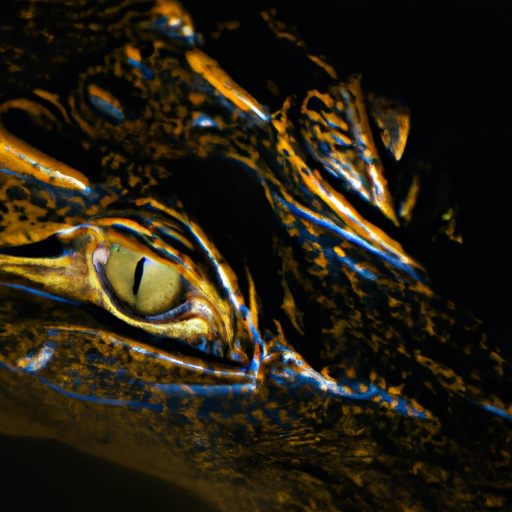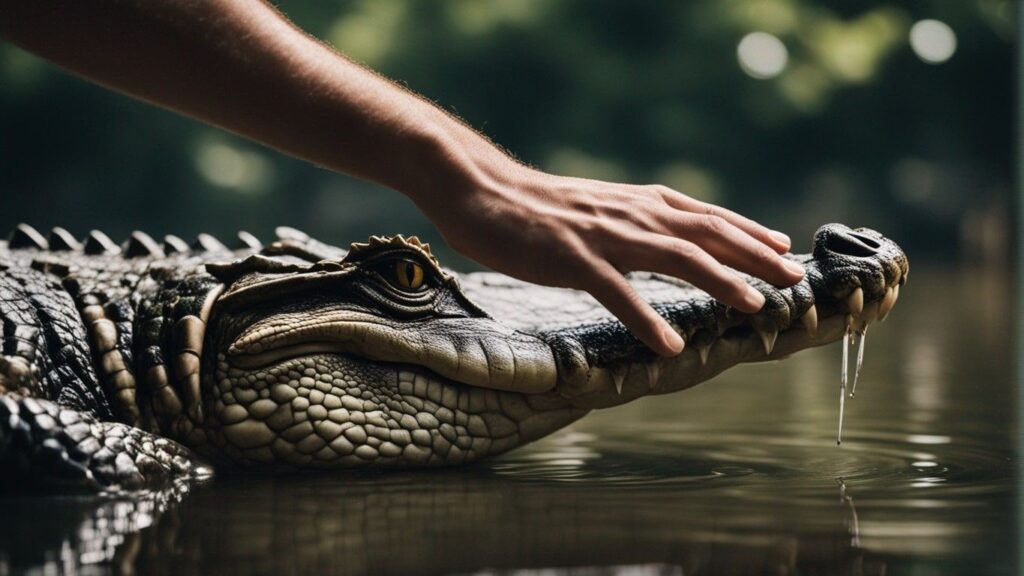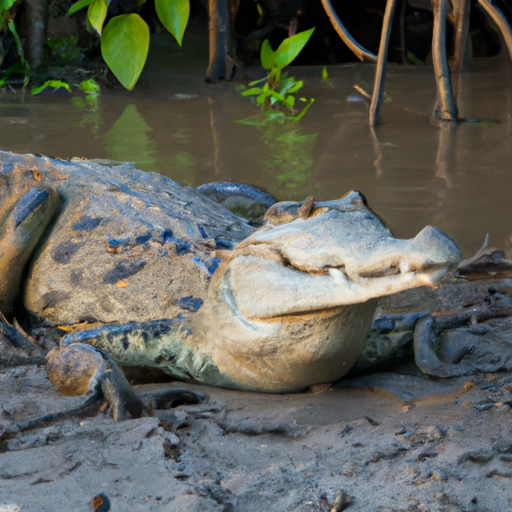So you’re curious about what hunts crocodiles, huh? Well, these formidable creatures may be at the top of the food chain in many ecosystems, but they are not without their own predators.
From stealthy predators lurking beneath murky waters to agile hunters on land, this article will shed light on the fascinating world of crocodile hunters.
Brace yourself for a wild ride as we explore the diverse cast of characters that make these ancient reptiles think twice before becoming the hunter or the hunted.
Get ready to be amazed by the cunning and adaptability of nature’s most skilled predators.

Natural Predators
Crocodiles, despite being apex predators themselves, still have a fair share of threats in the wild. Let’s explore some of the natural predators that pose a challenge to these fearsome reptiles.
Large Cats
In areas where both crocodiles and large cats coexist, clashes between these two powerful hunters are not unheard of. Tigers, lions, and jaguars are formidable predators known for their strength and agility. Although they may not intentionally go after crocodiles, if a confrontation were to occur, it would be a thrilling battle to witness. However, due to the difference in habitats, such encounters are rare and fascinating exceptions.
Birds of Prey
Birds of prey, such as eagles and ospreys, are skilled hunters that can pose a threat to crocodiles, especially their young. These birds have sharp talons and powerful beaks, which enable them to snatch small crocodiles with relative ease. Although adult crocodiles are generally safe from avian predators, they still need to remain vigilant when their hatchlings are near.
Sharks
When it comes to crocodiles, it’s not only the land-dwelling predators they need to be wary of. Sharks, particularly bull sharks and tiger sharks, are known to venture into brackish waters where crocodiles often thrive. In areas like the Australian coast or estuaries, these mighty marine predators can engage in fierce battles with crocodiles. While sharks are adept swimmers, crocodiles have their own unique adaptations to defend themselves underwater.
Other Crocodiles
Crocodiles are known for their territorial nature, and clashes between members of the same species can be just as lethal as battles with other predators. When competing for resources or defending their territory, crocodiles will not hesitate to fight fiercely. These combats can be intense and often result in serious injury or death, as both crocodiles are equipped with powerful jaws and armored skin.
Monitor Lizards
Another group of reptiles that pose a potential threat to crocodiles are monitor lizards. These long and agile predators, such as the Komodo dragon, are known for their ability to take down large prey. While monitor lizards would typically prefer to feast on smaller animals, they are not afraid to engage in confrontations with crocodiles if the opportunity presents itself. These encounters are infrequent but illustrate the diverse range of predators that crocodiles must navigate in their environments.
Human Predation
Despite their fearsome reputation, crocodiles face another significant threat – human predation. The interaction between crocodiles and humans has long been a subject of fascination and concern. Let’s explore the different aspects of this complex relationship.
Traditional Hunting
In various cultures around the world, crocodiles have been traditionally hunted for their skin, meat, and other body parts. Indigenous communities rely on these resources for sustenance and cultural practices. Traditional hunting methods, passed down through generations, often involve using spears, nets, or traps to capture crocodiles. While these practices are deeply rooted in culture, they can put additional pressure on crocodile populations if not managed sustainably.
Poachers
Unfortunately, alongside traditional hunting, there is also illegal poaching of crocodiles driven by the demand for their valuable skin, which is used in the production of luxury goods. Poachers relentlessly hunt crocodiles, often resorting to cruel and inhumane methods. This illegal trade not only harms crocodile populations but also disrupts the delicate balance of the ecosystems they inhabit.
Conflict with Humans
As urban areas expand and encroach upon natural habitats, the interaction between humans and crocodiles becomes increasingly problematic. In regions where crocodile populations exist in close proximity to human settlements, conflicts can arise. Crocodiles may venture into human-inhabited areas, attracted by food sources or simply due to habitat loss. Unfortunately, such encounters can result in human fatalities, leading to heightened fear and calls for crocodile removal.
Conservation Efforts
Recognizing the importance of conserving crocodile populations, numerous conservation organizations and government agencies are actively engaged in efforts to protect these magnificent reptiles. Measures such as habitat preservation, restricted hunting permits, and public education campaigns are aimed at ensuring the long-term survival of crocodiles. By promoting coexistence and raising awareness of the ecological role crocodiles play, conservation initiatives strive to strike a balance between human needs and the preservation of wildlife.
Underwater Predators
While crocodiles exhibit remarkable adaptability to both land and water, they are not the only predators in aquatic environments. Let’s dive deeper into the underwater domain to discover the formidable hunters that share these waters.
Marine Predators
In the vast expanse of the ocean, crocodiles encounter a wide array of marine predators. From agile dolphins and orcas to lightning-fast sharks, these marine hunters have evolved unique adaptations to dominate their watery realm. While direct interactions between crocodiles and marine predators are rare, crocodiles still need to be cautious while navigating shared coastal ecosystems.
Freshwater Predators
In freshwater environments such as rivers and lakes, crocodiles face a different set of underwater challenges. Fish species like pikes and barracudas, equipped with sharp teeth and lightning-fast strikes, dominate these habitats. Even though these fish are often the prey of crocodiles, they too pose a threat to their hatchlings, especially if they venture too close to their hunting grounds. It’s a constant cycle of predator and prey in the underwater world.

Amphibious Hunters
In certain regions where crocodiles reside, they share their habitat with other formidable hunters. These amphibious creatures possess their own set of skills that allow them to thrive both in water and on land. Let’s explore some of the notable amphibious hunters that coexist with crocodiles.
Dolphins
Known for their intelligence and agility, dolphins are remarkable predators in both coastal and open waters. With their echolocation abilities, dolphins can easily locate prey, which often includes fish, squid, and even smaller marine mammals. Though crocodiles primarily inhabit freshwater and brackish environments, they may occasionally encounter dolphins in coastal estuaries where both species overlap.
Hippopotamus
The mighty hippopotamus is another impressive creature that lives in close proximity to crocodiles. These massive herbivores may seem docile while grazing on the river banks, but they are not to be underestimated. In fact, hippos are known to be quite aggressive, especially when defending their territory and offspring. While conflict with hippos is not a frequent occurrence, crocodiles know better than to provoke these giant animals.
Elephants
In certain regions of Africa, crocodiles and elephants can often be found around the same watering holes. While these gentle giants are primarily herbivores, they possess enormous strength and can fend off potential threats, including crocodiles. However, their interactions with crocodiles are usually characterized by mutual respect, as both species understand the need to coexist peacefully for survival.
Water Buffaloes
Water buffaloes are another amphibious species that shares habitats with crocodiles in both freshwater and brackish environments. These strong and robust animals have a thick hide that can provide some protection against crocodile attacks. However, water buffaloes must remain cautious when approaching bodies of water as crocodiles are known for their stealth and ambush tactics.
Invasive Species
Invasive species pose a significant threat to ecosystems worldwide, and crocodile habitats are no exception. Let’s explore a few invasive predators that disrupt the delicate balance in environments where crocodiles reside.
Pythons
In regions where pythons have been introduced or have naturally expanded their range, they have become a major concern for crocodiles. These large constrictor snakes have the ability to take down even adult crocodiles, wrapping their massive bodies around them until suffocation occurs. The proliferation of pythons has had a severe impact on crocodile populations in some areas, throwing off the ecological balance.
Anguimorphs
Anguimorphs, a group of lizard-like reptiles, can also pose a threat to crocodiles when they compete for resources or come into direct contact. These anguimorph predators, which include species like the Nile monitor lizard, have similar habitats and dietary preferences as crocodiles. Consequently, they may compete for prey, nesting sites, and basking spots, creating potential conflicts between the two.
Monitor Lizards
Monitor lizards, whether native or invasive, are formidable hunters that can prey on crocodiles. These versatile and opportunistic reptiles, such as the Asian water monitor, have relatively few predators themselves and can exploit the vulnerabilities of other species. While encounters between monitor lizards and crocodiles are not frequent, they further illustrate the complex dynamics within these ecosystems.
Prey of Other Species
While crocodiles are often perceived as top-tier predators, they too have their own share of prey species. Let’s explore the diverse array of animals that find themselves on the menu for other predators in the wild.
Large Mammals
Crocodiles primarily target large mammals that come to the water’s edge to drink or cross rivers. Animals such as wildebeests, zebras, and deer can fall victim to a lurking crocodile’s ambush. The strength and stealth of crocodiles ensure that unsuspecting prey cannot escape their powerful jaws once latched onto.
Birds
Birds, particularly those that inhabit wetland areas, are frequent targets for crocodiles. Wading birds, ducks, and even smaller raptors become vulnerable when they approach the water in search of food or to rest. Crocodiles skillfully conceal themselves beneath the surface, waiting for the opportune moment to launch an attack.
Reptiles
Crocodiles are known to prey on other reptiles, including turtles, smaller crocodile species, and even snakes. This opportunistic feeding behavior further establishes their position as top predators within their ecosystems. The ability to prey on fellow reptiles showcases the impressive adaptability and resilience of crocodiles as hunters.
Amphibians
Amphibians, such as frogs and smaller salamanders, are not off the menu for crocodiles either. These slippery and agile creatures often become prey due to their proximity to water and the vulnerability that comes with their size. Crocodiles have a keen eye for spotting subtle movements in the water, allowing them to strike with lightning speed.
Fish
Fish make up a significant portion of the diet for crocodiles, particularly those inhabiting freshwater environments. Due to their streamlined bodies and swimming ability, fish can prove challenging to catch. However, crocodiles have adapted to these challenges by employing stealth and leveraging their powerful tails to create vibrations in the water, attracting unsuspecting fish within striking distance.
First Tiers of the Food Chain
At the foundation of every ecosystem lies the first tiers of the food chain, supporting the delicate balance of life. Let’s explore the crucial roles played by these organisms in the crocodile’s ecosystem.
Algae
Algae are microscopic photosynthetic organisms that serve as the primary producers in aquatic ecosystems. They convert sunlight into energy, providing a vital food source for a wide range of organisms, including smaller fish and invertebrates. Without the presence of algae, the entire food chain would collapse, depriving crocodiles of their prey.
Insects
Insects are abundant in both terrestrial and aquatic environments, and they play a crucial role as primary consumers in the food chain. Insects such as mosquitoes, dragonflies, and beetles provide a nutritious food source for a variety of animals, including small fish and amphibians. Crocodiles, in turn, benefit from a healthy insect population, as it ensures a steady supply of prey within their ecosystem.
Small Fish
Small fish, often referred to as forage fish or fry, are a fundamental component of the food chain. These small prey species, such as minnows and guppies, form schools and provide sustenance for larger fish, birds, and crocodiles alike. Crocodiles rely on the abundance of these small fish as a reliable food source, enabling them to grow and thrive within their habitats.
Ecosystem Balance
The presence of crocodiles in their natural habitats contributes significantly to the overall balance of the ecosystems they inhabit. Let’s explore the various ways in which crocodiles play an important ecological role.
Biodiversity
Crocodiles, as apex predators, help regulate the population of other species within their ecosystems. By keeping prey populations in check, crocodiles help maintain a healthy balance of biodiversity. The presence of crocodiles can prevent overgrazing and overpopulation of certain species, ensuring a diverse and varied ecosystem.
Ecological Role
Crocodiles also act as ecosystem engineers by shaping the environment around them. Through the construction of nesting mounds and burrows, crocodiles create habitats that are utilized by other species. Small mammals, reptiles, and birds often seek shelter in abandoned crocodile nests, benefiting from the natural structures created by crocodiles.
Population Control
As efficient hunters, crocodiles help regulate the population of certain prey species, which, if left unchecked, could have detrimental effects on the ecosystem. By preying on weaker individuals and maintaining healthy populations of prey species, crocodiles contribute to a balanced system that ensures the survival of the fittest and prevents overpopulation.
Crocodile Adaptations
Crocodiles have evolved a remarkable set of adaptations that allow them to thrive in their various habitats. These adaptations enable crocodiles to excel as predators in their ecosystems.
Stealthy Ambush Predators
Crocodiles are skilled ambush predators, waiting patiently for unsuspecting prey to approach the water’s edge. Their ability to blend into their surroundings, combined with their exceptional camouflage, allows them to remain largely undetected until it’s time to strike. This unparalleled stealth is crucial for their hunting success.
Strong Jaws and Teeth
One of the most striking features of crocodiles is their powerful jaws, armed with rows of razor-sharp teeth. Their bite force, unparalleled in the animal kingdom, allows them to deliver bone-crushing blows to prey, ensuring a quick and efficient kill. Crocodiles have the ability to regrow their teeth, ensuring that they are always at the peak of their hunting prowess.
Armored Skin
Crocodiles are protected by a tough, scaly skin that acts as armor against potential threats. Their thick, bony plates, called osteoderms, provide a layer of protection, especially around vital organs. This armored skin not only safeguards crocodiles from the claws and teeth of attackers but also helps them navigate treacherous environments.
Excellent Eyesight
Crocodiles possess exceptional eyesight, both in and out of the water. Their eyes are strategically positioned on top of their heads, allowing them to remain mostly submerged while still being able to keep a keen watch on their surroundings. Their eyes have a tapetum lucidum, a specialized structure that enhances their night vision, making them formidable nocturnal hunters.
Aquatic Locomotion
As semi-aquatic creatures, crocodiles have adapted to move efficiently in both water and on land. Their streamlined bodies, strong tails, and webbed feet allow them to navigate water with agility and speed. On land, they can rely on their powerful limbs to propel themselves forward, making it possible to traverse varying terrains to reach potential prey.
Regulating Body Temperature
Crocodiles are ectothermic animals, meaning they rely on external heat sources to regulate their body temperature. They can be found basking in the sun, absorbing warmth to kick-start their metabolism. Conversely, when the environment becomes too hot, crocodiles retreat to the water to cool down. Their ability to regulate body temperature helps maintain optimal physiological processes for their survival.
Final Thoughts
In the intricate web of predator-prey relationships and the delicate balance of ecosystems, crocodiles occupy a unique and formidable position.
While they face threats from large cats, birds of prey, and other predators, crocodiles themselves are apex predators, essential for maintaining biodiversity, population control, and ecological balance.
They have adapted over millions of years to become stealthy, powerful hunters, equipped with remarkable sight, strength, and armored skin.
As human interactions and invasive species pose additional challenges, conservation efforts become crucial to ensure the survival of these magnificent reptiles.
Understanding the intricate dynamics between crocodiles and their natural predators sheds light on the intricate tapestry of life in the wild.




